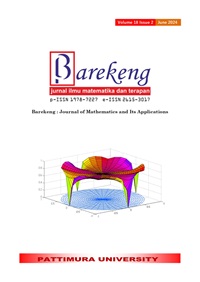LOSS MODEL OF CLIMATE INSURANCE BASED ON EFFECT OF GROWING DEGREE DAYS INDEX
Abstract
Climate change is a threat to agriculture, especially food crops such as rice. Climate index insurance is an alternative to cover the risk of agricultural losses due to crop failure due to climate change factors. The observed climate index is the effect of growing degree days which measures the impact of temperature on plant growth and development. The data used in this study is daily temperature data at Climatology Station Class 1 Darmaga, Bogor and Meteorological Station Class 3 Citeko, West Java, during the gadu (rice that is planted in the Gadu/Dry season) planting period. In determining the amount of loss, the average daily temperature on growing degree days is calculated using a combination of a time series model and a deterministic model. The deterministic model describes the trend and seasonality of the time series at each station. The parameters contained in the model will be estimated using least-square. To see the dependence of temperature at different stations using a normal bivariate distribution. The result show that the amount of loss based on the index of growing degree days per unit rupiah per degree Celsius (℃) for Meteorological Station Class 3 Citeko only occurs for certain percentages, namely 80%, 90%, and 95%, while for Climatology Station Class 1 Darmaga Bogor it can occur for each percentage. This indicates that the amount of losses obtained will depend on determining the strike level by using the mean and standard deviation of the growing degree days index distribution. Furthermore, these findings suggest that Climatology Station Class 1 Darmaga Bogor have higher risk of crop failure due to climate change than Meteorological Station Class 3 Citeko.
Downloads
References
A. Nawawi, “Analysis of Implementation Rice Farming Insurance in Indonesia: A Meta-Analysis,” Akurasi : Jurnal Anggaran dan Keuangan Negara Indonesia, vol. 5, no. 2, pp. 106-121, 2023.
M. Biswas, T. Dhoom and S. Barua, “Weather Forecast Prediction: An Integrated Approachfor Analyzing and Measuring Weather Data,” International Journal of Computer Applications, vol. 182, no. 34, pp. 20-24, 2018.
D. Kampolis, “Statistical Analysis for Long-Term Weather Forecast,” Environmental Sciences Proceedings, vol. 26, no. 1, pp. 30-35, 2023.
O. Okhrin, M. Odening and W. and Xu, “Systemic Weather Risk and Crop Insurance: The Case of China,” The Journal of Risk and Insurance, vol. 80, no. 2, pp. 351-372, 2013.
B. K. Goodwin and A. and Hungerford, “Copula-Based Models of Systemic Risk in U. S. Agriculture: Implications for Crop Insurance and Reinsurance Contracts,” American Journal of Agricultural Economics, vol. 97, no. 3, pp. 879-896, 2015.
V. Colovic and N. Mrvic-Petrovic, “Crop insurance: Risks and models of insurance,” Ekonomika poljoprivrede, vol. 61, no. 3, pp. 561-573, 2014.
G. Filler, M. Odening, O. Okhrin and W. and Xu, “On the Systemic Nature of Weather Risk,” Economic Risk, vol. 2, no. 1, pp. 1-19, 2009.
W. Estiningtyas, “Asuransi Pertanian Berbasis Indeks Iklim: Opsi Pemberdayaan dan Perlindungan Petani Terhadap Risiko Iklim,” Jurnal Sumberdaya Lahan, vol. 9, no. 1, pp. 51-64, 2015.
S. J. Collier, R. Elliott and T.-K. Lehtonen, “Climate change and insurance,” Economy and Society, vol. 50, no. 2, pp. 158-172, 2021.
G. Zhou and Q. Wang, “A new nonlinear method for calculating growing degree days,” Scientific Reports, vol. 8, pp. 1-14, 2018.
M. Masjkur and K. S. and Tan, “Comparing Decision Tree, Random Forest, and Boosting in Identifying Weather Index for Rice Yield Prediction,” in The 1st International Conference on Statistics and Analytics (ICSA), Bogor, 2020.
E. W. Frees and E. A. and Valdez, “Understanding Relationships using Copulas,” North American Actuarial Journal, vol. 2, no. 1, pp. 1-25, 1998.
S. Di Falco, F. Adinolfi, M. Bozzola and F. Capitanio, “Crop Insurance as a Strategy for Adapting to Climate Change,” Journal of Agricultural Economics, vol. 65, no. 2, pp. 485-504, 2014.
A. Najiha, E. T. Herdiani and G. M. Tinungki, “The Application of Gumbel Copula to Estimate Value at Risk with Backtesting in Telecommunication Stock,” Barekeng: Journal of Mathematics and Its Applications, vol. 17, no. 1, pp. 245-252, 2023.
N. W. Deresa, I. van Keilegom and K. Antonio, “Copula-based inference for bivariate survival data with left truncation and dependent censoring,” Insurance: Mathematics and Economics, vol. 107, no. 1, pp. 1-21, 2022.
R. V. Hogg, J. W. McKean and A. T. and Craig, Introduction to Mathematical Statistics, 8th Edition, Boston: Pearson, 2019.
Y. A. Mustefa and D.-G. Chen, “Accelerated failure-time model with weighted least-squares estimation: application on survival of HIV positives,” Archives of Public Health, vol. 79, no. 88, pp. 1-7, 2021.
A. Z. Saiz, C. Q. Gonzales, L. H. Gil and D. M. Ruiz, An Introduction to Data Analysis in R, Switzerland: Springer Nature Switzerland AG, 2020.
R. H. Shumway and D. S. Stoffer, Time Series Analysis and Its Applications with R Examples, 4th Edition, New York: Springer, 2017.
Copyright (c) 2024 I Gusti Ayu Wulan Anggasari, Ahmad Fuad Zainuddin, Sapto Wahyu Indratno, Muhammad Haekal Yunus

This work is licensed under a Creative Commons Attribution-ShareAlike 4.0 International License.
Authors who publish with this Journal agree to the following terms:
- Author retain copyright and grant the journal right of first publication with the work simultaneously licensed under a creative commons attribution license that allow others to share the work within an acknowledgement of the work’s authorship and initial publication of this journal.
- Authors are able to enter into separate, additional contractual arrangement for the non-exclusive distribution of the journal’s published version of the work (e.g. acknowledgement of its initial publication in this journal).
- Authors are permitted and encouraged to post their work online (e.g. in institutional repositories or on their websites) prior to and during the submission process, as it can lead to productive exchanges, as well as earlier and greater citation of published works.






1.gif)



